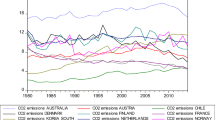Abstract
US economic growth and air pollution were decoupled after 1970. Possible explanations include regulation, oil price shocks, technology and income growth. This paper uses VAR analysis to show that the 1970 Clean Air Act (CAA) may have actually increased pollution in the short run but led to accelerated improvements in abatement technology. Gross domestic product and consumption growth had little direct effect while oil price increases caused small but significant emissions reductions. Recursive simulation shows that overall, the CAA, by accelerating improvements in abatement technology, reduced total emissions as of 1998 to 46% of what they would have been.
Similar content being viewed by others
References
Andreoni J, Levinson A (2001) The simple analytics of the environmental Kuznets curve. J Public Econ 80:269–286
Bierans H (2003) EasyReg International Econometrics Software. http://www.econ.la.psu.edu/hbierens/EASYREG.HTM
Bradford DF, Schliekert R, Shore SH (2000) The environmental Kuznets curve: exploring a fresh specification. National Bureau of Economic Research Working Paper 8001
Breitung J (2002) Nonparametric tests for unit roots and cointegration. J Econom 108:343–363
Brock WA, Taylor MS (2004) The Green Solow Model. NBER Discussion Paper 10557
Bruvoll A, Medin H (2003) Factors behind the environmental Kuznets curve. Environ Resour Econ 24:27–48
Crandall RW (1992) Policy Watch: corporate average fuel economy standards. J Econ Perspect 6(2):171–180
Environmental Protection Agency (1997) The benefits and costs of the Clean Air Act 1970–1990. Report to United States government, available at http://www.epa.gov/air/sect812/copy.html, accessed March 4, 2005
Greenstone M (2004) Did the Clean Air Act cause the remarkable decline in Sulfur Dioxide concentrations?. J Environ Econ Manage 47:585–611
Grossman GM, Kreuger AB (1995) Economic growth and the environment. Q J Econ 3:53–77
Gruenspecht, Howard K (1982) Differentiated regulation: the case of auto emission standards. Am Econ Rev 72(2):328–331
Gruenspecht HK, Stavins RN (2002) New source review under the Clean Air Act: ripe for reform. Resources 147:19–23
Harrington W, McConnell V (1999) Coase and car repair: who should be responsible for emissions of vehicles in use? Resources for the Future Discussion Paper, pp 99–22
Henderson V (1996) Effects of air quality regulation. Am Econ Rev 86(4):789–813
Huq M, Wheeler D (1993) Pollution reduction without formal regulation: evidence from Bangladesh. World Bank Environment Divisional Working Paper #1993–39
Jorgensen DW, Wilcoxen PJ (1990) Environmental regulation and U.S. economic growth. Rand J Econ 21(2):314–340
Juselius K (1993) VAR modeling and Haavelmo’s probability approach to macroeconomic modelling. In: Raj B, Dufour JM (eds) Empirical economics special issue: new developments in time series. Econometrics 18:595–622
Kahn ME (2001) The beneficiaries of Clean Air Act regulation. Regulation, pp 34–38
Kleit AN (1990) The effect of annual changes in automobile fuel economy standards. J Regul Econ 2(2):151–172
Krupnick A (2002) Performance of the Clean Air Act and its amendments. Testimony to the Subcommittee on Energy and Air Quality, Committee on Energy and Commerce, US House of representatives
Kwoka JE (1983) The limits of market-oriented regulatory techniques: the case of automotive fuel economy. Q J Econ 98(4):695–704
Lanne M, Liski M (2004) Trends and breaks in per-capita carbon dioxide emissions, 1870–2028. Energy J 25(4):41–65
List JA (1999) Have air pollutant emissions converged among US regions? evidence from unit root tests. Southern Econ J 66(1):144–155
List JA, Gallett CA (1999) The environmental Kuznets curve: does one size fit all? Ecol Econ 31:409–423
List JA, McHone W (2000) Measuring the effects of air quality regulations on dirty firm births: evidence from the neo- and mature-regulatory periods. Pap Reg Sci 79:177–190
List JA, Millimet DL, McHone W (2004) The unintended disincentive in the Clean Air Act, advances in economic analysis & policy, vol 4:No. 2, Article 2. http://www.bepress.com/bejeap/advances/vol4/iss2/art2
López R (1994) The environment as a factor of production: the effects of economic growth and trade liberalization. J Environ Econ Manage 27:163–184
McKitrick R (1999) A derivation of the marginal abatement cost function. J Environ Econ Manage 42:306–314
McKitrick R, Strazicich M (2005) Stationarity of global per capita carbon dioxide emissions: implications for global warming scenarios. University of Guelph, Department of Economics, Discussion Paper 2005–3
Moomaw W, Unruh GC (1997) Are environmental Kuznets curves misleading us? the case of CO2 emissions. Environ Dev Econ 2:451–463
Popp D (2001) Pollution control innovations and the Clean Air Act of 1990. National Bureau of Economic Research Working Paper No. W8593
Rask K (2004) Clean air policy and oxygenated fuels: do we get what we pay for? Energy Econ 26:161–177
Selden T, Song D (1994) Environmental quality and development: is there a Kuznets curve for air pollution emissions? J Environ Econ Manage 27:147–162
Sims CA, Stock J, Watson M (1990) Inference in linear time series models with some unit roots. Econometrica 58(1):113–144
Stanton TJ (1993) Capacity utilization and new source bias: evidence from the U.S. electric power industry. Energy Econ 15(1):57–60
Stokey NL (1998) Are there limits to growth? Int Econ Rev 39(1):1–31
Thorpe SG (1997) Fuel economy standards, new vehicle sales, and average fuel efficiency. J Regul Econ 11(3):311–326
Tiao GC, Tsay RS, Wang T (1993) Usefulness of linear transformations in multivariate time series analysis. In: Raj B, Dufour JM (eds) Empirical economics special issue: new developments in time series Econometrics 18:567–593
Toda HY, Phillips PCB (1993) Vector autoregressions and causality. Econometrica 61(6):1367–1393
United States Environmental Protection Agency (2003) National emission inventory air pollutant emission trends. http://www.epa.gov/ttn/chief/trends/index.html
United States Federal Highway Administration (2003) Transportation air quality: selected facts and figures. http://www.fhwa.dot.gov////environment/aqfactbk/factbk12.htm#t26
Unruh GC, Moomaw WR (1998) An alternative analysis of apparent EKC-type transitions. Ecol Econ 25:221–229
White LJ (1982) U.S. automotive emission controls: how well are they working? Am Econ Rev 72(2):332–335
White K (1993) SHAZAM 7.0 user’s reference manual. McGraw-Hill, Toronto
World Bank New Ideas in Pollution Control (2003) The role of community in pollution control. http://www.worldbank.org/nipr/comrole.htm
Author information
Authors and Affiliations
Corresponding author
Rights and permissions
About this article
Cite this article
McKitrick, R. Why did US air pollution decline after 1970?. Empirical Economics 33, 491–513 (2007). https://doi.org/10.1007/s00181-006-0111-4
Received:
Accepted:
Published:
Issue Date:
DOI: https://doi.org/10.1007/s00181-006-0111-4




